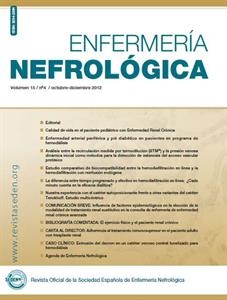Contenido del artículo principal
Resumen
El día a día del trabajo de la enfermería en las unidades de hemodiálisis (HD) nos demuestra la gran incidencia del uso de catéteres venosos centrales tunelizados como accesos vasculares para realizar dicha técnica. Estos catéteres, como todos sabemos, no están exentos de problemas con los que nos vamos encontrando más a menudo de lo que desearíamos (disfunciones por falta de flujo, aumento de presión venosa, etc.) y que afortunadamente conseguimos resolver antes de iniciar la sesión o durante la misma en la gran mayoría de ocasiones. Además de las complicaciones más graves como infecciones, trombosis1, etc. existe otra, no muy frecuente, pero no por ello menos importante, como es la extrusión del manguito (cuff) de dacron (en adelante dacron) en un catéter venoso central tunelizado. Según las recomendaciones existentes, requiere el recambio del catéter2, lo que se suele realizar de una manera sistemática, con mayor o menor prontitud, previa información y consentimiento del propio paciente; información y consentimiento regulados por la "Ley 41/2002, de 14 de Noviembre, básica reguladora de la autonomía del paciente y de derechos y obligaciones en materia de información y documentación clínica" ("...el paciente o usuario tiene derecho a decidir libremente después de recibir información adecuada entre las opciones clínicas disponibles")3. Se presentó en nuestra Unidad, un caso de extrusión del dacron en un catéter venoso tunelizado para HD, negándose la paciente a su sustitución, amparándose en la ley anteriormente citada.
Palabras clave
Detalles del artículo
Derechos de autor 2012 Isabel Crehuet Rodríguez, Pilar Méndez Briso-Montiano, María Albina Bernárdez-Lemus

Esta obra está bajo una licencia internacional Creative Commons Atribución-NoComercial 4.0.
Aviso de derechos de autor/a
© Los autores ceden de forma no exclusiva los derechos de explotación de los trabajos publicados y consiente en que su uso y distribución se realice con la Licencia Creative Commons Atribución - No comercial 4.0 Internacional (CC BY-NC 4.0). Puede consultar desde aquí la versión informativa y el texto legal de la licencia. Esta circunstancia ha de hacerse constar expresamente de esta forma cuando sea necesario.
Referencias
- C1. Guías S.E.N. Guías de acceso vascular en hemodiálisis. Nefrología.2005; 25 (supl. 1): 1-174.
- Foraster A, Ocharán J. Actitud que hay que seguir ante los problemas más frecuentes de los accesos vas-culares. González Álvarez MT, Martínez de Cercos R. Manual de accesos vasculares para hemodiálisis. Barcelona: Marge Médica Books; 2010: 221-229.
- BOE nº 274 de 15-11-2002, página 40216. Capítulo I. Principios generales. Artículo 2. Puntos 2 y 3.
- Solozábal CA. Utilización de catéteres y tipos. González Álvarez MT, Martínez de Cercos R. Manual de accesos vasculares para hemodiálisis. Barcelona: Marge Médica Books; 2010: 75-83.
- Crehuet Rodríguez I, Méndez Briso-Montiano P, Mulero San José MT, Bernárdez Lemus M, Jiménez Maldonado A, Toribio Manrique B. Recirculación de la sangre durante de la sesión de hemodiálisis en el catéter tunelizado Palindrome ™. Rev Soc Esp Enferm Nefrol. 2012; 15 (1): 22-27.
- Tal MG. Comparison of recirculation percentage of the palindrome catheter and standard hemodialysis catheters in a swine model. J Vasc Interv Radiol. 2005; 16(9): 1237-1240.
- Martínez de Merlo MT Manual de Accesos Vascu-lares para Hemodiálisis: Fístulas Arteriovenosas y Catéter Venoso Central. Cuidados de Enfermería. Madrid: SEDEN; 2012: 71.
- Nissenson AR, Fine RN. Manual de diálisis. Cuarta edición. Barcelona: Elsevier Masson; 2009.
- Gómez Castilla C, Páez Antúnez MC, Ojeda Guerrero MA, Aresté Fonsalba, Ramírez López MA, Fernández Gordillo D. La extrusión del dacron subcutáneo como tratamiento de la infección crónica del orificio de salida del catéter de diálisis peritoneal” Rev Soc Esp Enferm Nefrol. 2011; 14 (4): 276.
- NKF,K/DOQI clinical practice guidelines for hemodialysi adecuacy 2000. Am J Kidney Dis,2001; 37 (Suppl 1): 57-64.
- Maduell F, García M, Alcázar R. Dosificación y adecuación del tratamiento dialítico. Guías SEN de centros de Hemodiálisis. Gestión de la calidad de HD. Nefrología. 2006: 26 (supl. 8): 15-20.
Referencias
C1. Guías S.E.N. Guías de acceso vascular en hemodiálisis. Nefrología.2005; 25 (supl. 1): 1-174.
Foraster A, Ocharán J. Actitud que hay que seguir ante los problemas más frecuentes de los accesos vas-culares. González Álvarez MT, Martínez de Cercos R. Manual de accesos vasculares para hemodiálisis. Barcelona: Marge Médica Books; 2010: 221-229.
BOE nº 274 de 15-11-2002, página 40216. Capítulo I. Principios generales. Artículo 2. Puntos 2 y 3.
Solozábal CA. Utilización de catéteres y tipos. González Álvarez MT, Martínez de Cercos R. Manual de accesos vasculares para hemodiálisis. Barcelona: Marge Médica Books; 2010: 75-83.
Crehuet Rodríguez I, Méndez Briso-Montiano P, Mulero San José MT, Bernárdez Lemus M, Jiménez Maldonado A, Toribio Manrique B. Recirculación de la sangre durante de la sesión de hemodiálisis en el catéter tunelizado Palindrome ™. Rev Soc Esp Enferm Nefrol. 2012; 15 (1): 22-27.
Tal MG. Comparison of recirculation percentage of the palindrome catheter and standard hemodialysis catheters in a swine model. J Vasc Interv Radiol. 2005; 16(9): 1237-1240.
Martínez de Merlo MT Manual de Accesos Vascu-lares para Hemodiálisis: Fístulas Arteriovenosas y Catéter Venoso Central. Cuidados de Enfermería. Madrid: SEDEN; 2012: 71.
Nissenson AR, Fine RN. Manual de diálisis. Cuarta edición. Barcelona: Elsevier Masson; 2009.
Gómez Castilla C, Páez Antúnez MC, Ojeda Guerrero MA, Aresté Fonsalba, Ramírez López MA, Fernández Gordillo D. La extrusión del dacron subcutáneo como tratamiento de la infección crónica del orificio de salida del catéter de diálisis peritoneal” Rev Soc Esp Enferm Nefrol. 2011; 14 (4): 276.
NKF,K/DOQI clinical practice guidelines for hemodialysi adecuacy 2000. Am J Kidney Dis,2001; 37 (Suppl 1): 57-64.
Maduell F, García M, Alcázar R. Dosificación y adecuación del tratamiento dialítico. Guías SEN de centros de Hemodiálisis. Gestión de la calidad de HD. Nefrología. 2006: 26 (supl. 8): 15-20.




